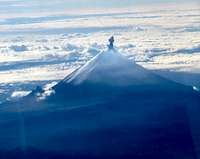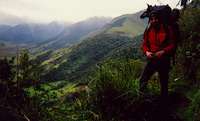|
|
Mountain/Rock |
|---|---|
|
|
2.0054°S / 78.3386°W |
|
|
Hiking |
|
|
Spring, Summer, Fall, Winter |
|
|
17158 ft / 5230 m |
|
|
Overview
Probably the most active volcano in South America if not in the whole world. During spring 2005 there were up to 3 eruptions / hour, mainly gas explosions as there was no more sign of red hot rocks of impressive size reported decades ago.
The approach is very demanding and the weather very humid. That's why there are not many people (few dozens / year) climbing this member of the Ecuadorian Big Ten (+ 5000m).
The most common route is basically a walk-up or hardly an alpine grade F if there is ice (imbibed volcanic ash frozen due to low temperature for example).
The first successful ascent of the mountain was realized by Waddell Austin, Robert Moore, Terris Moore and Lewis Thorne (USA) on August 4th, 1929 in a 18-day trip in continuous rain !
When To Climb
The mountain is climbable all year round but the expected "less humid" season is from November to February. July and August are considered the wettest. You have also to consider that the western side of the volcano is less humid than the eastern (Amazonian) side. To size the importance of “humidity” in your approach consider what Chris Bonington wrote about his 9 days experience of Sangay: “…every foot of the way had to be hacked from the impenetrable entanglement presented by the undergrowth.”
Mountain Conditions
So far there is no weather, snow conditions monitoring of Sangay. The only continuous monitoring concerns its volcanic and geologic activity (look for it in "LINKS").
Sangay summit is hidden by clouds most of the time and is only unveiled sometimes at the end of the day. Thus, the mountain is mostly climbed during the night when clouds are low.
The once known glacier on Sangay has disappeared. The upper part of the volcano may or may not be covered by occasional snow.
Getting There
In the past, the most common way of getting to the mountain was from Alao village. Now days, the access from Guagalla village is the most convenient as shorter (2 days) and mule hauling is possible most of the way if not all the way to the base of the volcano (depending trail conditions) From the City of Riobamba head south to the town of Licto. There arrange a pick-up to Guargualla (this is a dirt road with a pass at +4000m).
Red Tape
The Volcano is situated inside the boundaries of Parque Nacional Sangay and there is a 10 $ entrance permit.
This should be purchased from the INEFAN office at the main entrance of the park in Alao (a village East of Licto), or may be from the Headquarters at the Ministerio de Ambiente in Quito. Trekkers should respect the park regulation, bottom line: Pack in / pack out and no hunting. This is a major issue, as the park is the last sizeable refuge for the mountain tapir, an endangered specie.
Camping / Shelters
Camping is allowed every where.
There are 2 "chosa" shelters on the approach from Guargalla: one for each night to spend on the way to and back from the summit: at "Plazapampa" just after entering Parque Nacional Sangay; and at "La Playa" at the base of the volcano.
Objective Danger
In addition to objective danger resulting of continuous activity of the volcano, lack of snow has increased rock fall hazard. By 9 am and/or in windy conditions unstable rocks are dislodged and roll down the slopes impressively fast. Helmet is a necessity yet may not suffice... Avoid roping to each other for freedom of motion.
Watch out for sulfur gas emanation near volcano crater. It irritates lungs and throat. It’s quite mean because you’ll not feel the consequences until few hours later… The lesser time you spend on the summit plateau the better.
Native Guides
I recommend hiring native guides from Guargualla instead of Alao. I tried Sangay from both Guargualla and Alao (May 2005). It is not because the path to the base of the volcano is shorter from Guargalla (2 days instead of 2 to 3 days from Alao) but because:
1- the Guargalla guides are between 25 and 40, the main ones from Alao are above 45. I hired Roberto Caz from Alao. He may have been a great guide in the past, but this time he was really lacking motivation even to reach "La Playa".
2- the Guargalla guides are fully equipped (plastic boots, rain wear, crampons, ice axe, etc.) the best equipped guides of Alao (the Cruz brothers) have just crampons and ice axe, the rest have none of these.
3- The "sales man" of Guargualla Community Guides is Rafael Ushca of Licto (he is the only one selling guided tours in Licto). He asked for 15$/day for the guide, 15$/day for the horse and 60$ for the summit bid. I bargained a bit and paid 15$/ day for the guide and 10$/day for the horse and 60 $ for the summit. I found out the actual price is 12$ for the guide and 10$ for the horse. In Alao Jose Bano Masa asked for a fair 10$/ day but had absolutely no equipment (asking for a tent, rain gear, crampons, etc.) The Caz brothers (actually the price was negotiated mostly with Carlos) asked for a "package price" of 500$ without mule !!!!!!!! After tough negotiation with the intervention of Roberto we agreed on 150$ "package price". I later understood the Caz brothers policy consist of doing all they can to push the customer to give up. Carlos then standing for the whole "package price", whereas Roberto accepting a fair 15$/day fee.
External Links
- Volcanic activity of Sangay
Several reports on Sangay volcanic activity.
Normally there should be updates if situation changes...
- François Panchard's Sangay Page
- Mad team Sangay page
General description and pictures of Sangay in Spanish and Catalan.










Socorro - Nov 16, 2011 11:41 am - Hasn't voted
Entry costCost to enter Sangay National Park is $2 for both nationals and foreigners. They say you need to buy the pass in the office in Riobamba, but quite a few people show up in Alao without it. There´s a park guard office (Alao Llactapamba) that is usually - though not always - staffed Monday through Friday including all night. The guard leaves Friday afternoon for the weekend. The current guard allows visitors to stay in the guardhouse for free.